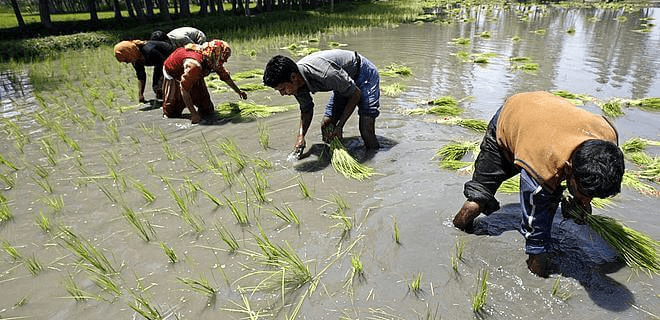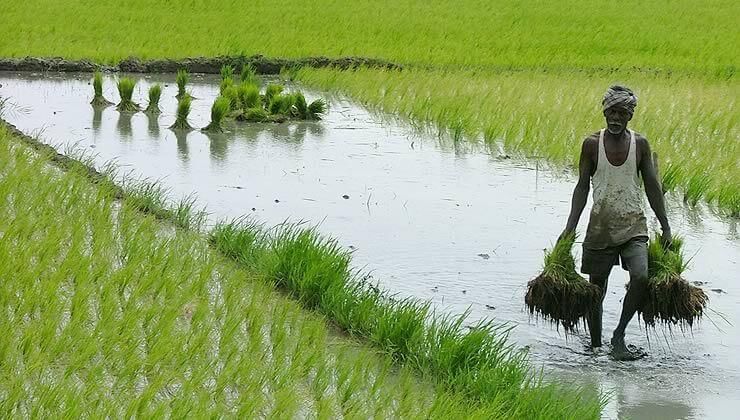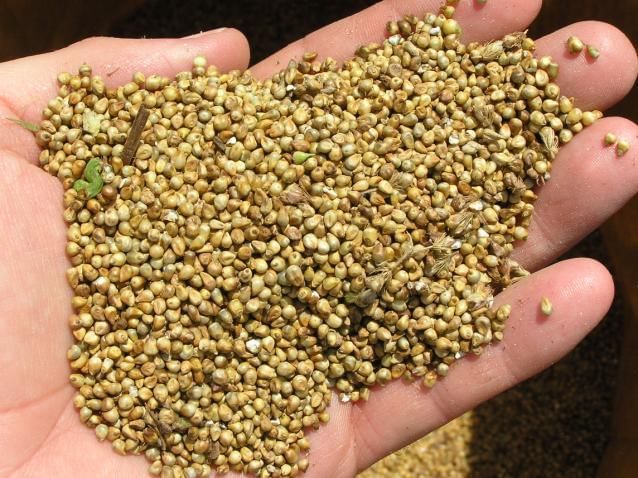Class 10 Geography Chapter 4 Notes - Agriculture
| Table of contents |

|
| Introduction |

|
| Types of Farming |

|
| Cropping Pattern |

|
| Non-Food Crops |

|
| Technological and Institutional Reforms |

|
Introduction
India, with its vast agricultural landscape, stands as a significant player in the realm of agriculture. This sector is fundamental to the nation's economy, engaging two-thirds of its population in various agricultural activities.
Agriculture in India is crucial for:
- Food Production: It provides the majority of the food consumed across the country.
- Raw Materials: It supplies essential raw materials for numerous industries.
Agriculture is a primary activity that provides most of our food and supplies raw materials for many industries.
 Agriculture
Agriculture
Types of Farming
- Agriculture has been a key activity in our country for a long time.
- Farming methods have changed a lot due to the environment, technology, and social practices.
- There are different types of farming, from small-scale to commercial, practiced across India.
The various types of farming systems in different parts of India are:
Primitive Subsistence Farming

- Primitive subsistence farming is still practiced in some regions of India.
- Conducted on small patches of land using basic tools like hoe, dao, and digging sticks.
- Relies on family or community labor and depends on the monsoon, natural soil fertility, and favorable environmental conditions.
- Also known as "slash and burn" farming, where farmers clear a patch of land to grow cereals and food crops.
- When soil fertility declines, farmers move to a new patch, allowing the land to naturally regain its fertility over time.
- Productivity is low due to the lack of fertilizers and modern inputs.
- Regional Names:
- Known as "jhumming" in the northeastern states (Assam, Meghalaya, Mizoram, Nagaland).
- Called "Pamlou" in Manipur, "Dipa" in Bastar district of Chhattisgarh, and practiced in the Andaman and Nicobar Islands.
 Primitive Subsistence Farming
Primitive Subsistence Farming
- It is jhumming in north-eastern states like Assam, Meghalaya, Mizoram, and Nagaland; Pamlou in Manipur, Dipa in Bastar district of Chhattishgarh, and in Andaman and Nicobar Islands.
- Jhumming: The 'slash and burn' agriculture is known as 'Milpa' in Mexico and Central America, 'Conuco' in Venezuela, 'Roca' in Brazil, 'Masole' in Central Africa, 'Ladang' in Indonesia, 'Ray' in Vietnam.
- In India, this primitive form of cultivation is called 'Bewar' or 'Dahiya' in Madhya Pradesh, 'Podu' or 'Penda' in Andhra Pradesh, 'Pama Dabi' or 'Koman' or 'Bringa' in Odisha, 'Kumari' in Western Ghats, 'Valre' or 'Waltre' in South-eastern Rajasthan, 'Khil' in the Himalayan belt, 'Kuruwa' in Jharkhand, and 'Jhumming' in the North-eastern region.
Intensive Subsistence Farming
This type of farming is labour-intensive farming, where high doses of biochemical inputs and irrigation are used to obtain higher production. This method is commonly used where less landholding is available.
 Intensive Subsistence Farming
Intensive Subsistence Farming
Pressure on Agricultural Land
- Division of Land: The right of inheritance often results in land being divided among successive generations, leading to smaller, less economical landholdings.
- Maximizing Output: Despite the reduction in land size, farmers strive to maximize output from their limited land due to the lack of alternative livelihoods.
- Resulting Pressure: This situation creates significant pressure on agricultural land as farmers work intensively to make the most of the available space.
Commercial Farming
This type of farming is done using higher doses of modern inputs, e.g. high yielding variety (HYV) seeds, chemical fertilisers, insecticides and pesticides in order to obtain higher productivity.
Variation in Commercialization: Agriculture's commercial level differs by region. For instance, rice is commercial in Haryana and Punjab but subsistence in Odisha.
- Examples of Crop Variation: Some crops are commercial in one area but subsistence in another.
- Examples: Tea, coffee, rubber, sugarcane, banana.
- Plantation Farming: Growing a single crop on extensive land, combining agriculture and industry. Plantations cover large tracts of land, using capital intensive inputs, with the help of migrant labourers. All the produce is used as a raw material in industries.
- Plantation Crops in India: Tea in Assam and North Bengal, and coffee in Karnataka are important plantation crops.
- Development of Plantations: Well-established transport and communication networks are crucial for plantation growth.
 Commercial Farming
Commercial Farming
Cropping Pattern
Cropping pattern changes are seen in the way farming is done and the crops that are grown. In India, important crops include various types of food and fiber crops, vegetables, fruits, spices, and condiments.
India has three cropping seasons:
1. Rabi:
- Rabi crops are sown during the winter, from October to December, and are harvested in summer, from April to June.
- Important rabi crops include wheat, barley, peas, gram, and mustard.
- These crops are mainly grown in various parts of India, with states in the north and north-west such as Punjab, Haryana, Himachal Pradesh, Jammu and Kashmir, Uttarakhand, and Uttar Pradesh playing crucial roles in wheat and rabi crop production.
- The presence of winter precipitation, brought by western temperate cyclones, is beneficial for these crops.
- The success of the green revolution in regions like Punjab, Haryana, western Uttar Pradesh, and parts of Rajasthan has significantly contributed to the growth of these rabi crops.

Rabi Crop
2. Kharif:
- Kharif crops are planted when the monsoon begins in various parts of the country and are harvested between September and October.
- Major crops grown during this time include paddy, maize, jowar, bajra, tur (arhar), moong, urad, cotton, jute, groundnut, and soyabean.
- Important regions for rice cultivation include Assam, West Bengal, coastal areas of Odisha, Andhra Pradesh, Telangana, Tamil Nadu, Kerala, Maharashtra (especially the Konkan coast), Uttar Pradesh, and Bihar.
- In Punjab and Haryana, paddy has also become significant recently.
- In states like Assam, West Bengal, and Odisha, three types of paddy crops are grown each year: Aus, Aman, and Boro.
 Kharif Crop
Kharif Crop
3. Zaid:
- In between the rabi and kharif seasons, there is a short season during the summer months known as the Zaid season.
- Some of the crops grown during the 'Zaid' season include watermelon, muskmelon, cucumber, vegetables, and fodder crops.
- Sugarcane takes nearly a year to mature.
 Watermelon
Watermelon
( A Zaid Crop)
Major Crops
Major crops grown in India are rice, wheat, millets, pulses, tea, coffee, sugarcane, oilseeds, cotton and jute, etc.
Rice
- Staple food crop
- Our country is the second-largest producer of rice in the world after China.
- It is a kharif crop that requires high temperature, (above 25°C) and high humidity with annual rainfall above 100 cm.
- It is grown in the plains of north and north-eastern India, coastal areas and the deltaic regions.
- Development of dense network of canal irrigation and tubewells have made it possible to grow rice in areas of less rainfall such as Punjab, Haryana and western Uttar Pradesh and parts of Rajasthan.
 Distribution of Rice
Distribution of Rice
Wheat
- The second most important cereal crop.
- It is the main food crop, in the north and north-western part of the country.
- This rabi crop requires a cool growing season with 50 to 75 cm of annual rainfall and bright sunshine at the time of ripening.
- Wheat growing regions are the Ganga-Satluj plains in the northwest and black soil region of the Deccan.
- There are two important wheat-growing zones in the country – the Ganga-Satluj plains in the north-west and black soil region of the Deccan.
- The major wheat-producing states are Punjab, Haryana, Uttar Pradesh, Madhya Pradesh, Bihar and Rajasthan.

Millets
- Jowar, bajra, and ragi are significant millets cultivated in India.
- Even though they are categorized as coarse grains, they possess high nutritional value.
- Ragi is notably abundant in iron, calcium, other essential nutrients, and fiber.
- Jowar ranks as the third most crucial food crop in terms of cultivation area and yield.
- Primarily rain-fed, it thrives in moist regions, requiring minimal irrigation.
- Key Jowar producing states include Maharashtra, Karnataka, Andhra Pradesh, and Madhya Pradesh.
- Bajra thrives in sandy and shallow black soils.
- Major Bajra producing states encompass Rajasthan, Uttar Pradesh, Maharashtra, Gujarat, and Haryana.
- Ragi flourishes in arid areas, thriving in red, black, sandy, loamy, and shallow black soils.
- Key ragi producing states consist of Karnataka, Tamil Nadu, Himachal Pradesh, Uttarakhand, Sikkim, Jharkhand, and Arunachal Pradesh.
 A Pearl Millet ( Bajra)
A Pearl Millet ( Bajra)
Maize
- It is a Kharif crop.
- It requires a temperature between 21°C to 27°C and grows well in old alluvial soil.
- It is used both as food and fodder.
- Use of modern inputs such as HYV seeds, fertilisers and irrigation have contributed to the increasing production of maize.
- Major maize-producing states are Karnataka, Madhya Pradesh, Uttar Pradesh, Bihar, Andhra Pradesh and Telangana.
Pulses
- India is the largest producer as well as the consumer of pulses in the world.
- Pulses are a major source of protein in vegetarian diets. Tur (Arhar), Urad, Moong, Masur, Peas, and Gram.
- Pulses require less moisture and can thrive in dry conditions.
- Except for arhar, all pulses are leguminous and help in restoring soil fertility by fixing nitrogen from the air.
- Pulses are often grown in rotation with other crops to maintain soil health.
- Major producing states in India are Madhya Pradesh, Uttar Pradesh, Rajasthan, Maharashtra and Karnataka.
Food Crops other than Grains
Sugarcane
- It is a tropical as well as a subtropical crop.
- It grows well in a hot and humid climate with a temperature of 21°C to 27°C and an annual rainfall between 75 cm and 100 cm.
- India is the second largest producer of sugarcane only after Brazil.
- It is the main source of sugar, gur (jaggary), khandsari and molasses.
- Major producing states are Uttar Pradesh, Maharashtra, Karnataka, Tamil Nadu, Andhra Pradesh, Bihar, Punjab and Haryana.
Oil Seeds
- In 2018, India was the second biggest producer of groundnut globally, following China.
- Regarding rapeseed production in 2018, India ranked as the third top producer worldwide, after Canada and China.
- Around 12% of India's total cropped area is dedicated to cultivating various oil seeds.
- The primary oil seeds grown in India include groundnut, mustard, coconut, sesame (til), soybean, castor seeds, cotton seeds, linseed, and sunflower.
- Most of these oil seeds are edible and commonly used for cooking purposes. However, some are also utilized in the manufacturing of soap, cosmetics, and ointments.
- Groundnut is a summer crop and contributes to about half of the major oil seeds produced in India.
- In 2019-20, Gujarat led as the largest producer of groundnut, followed by Rajasthan and Tamil Nadu.
- Linseed and mustard are winter crops, while sesame is grown in summer in the north and winter in the south of India. Castor seed is cultivated in both winter and summer seasons.
 Different Oilseeds
Different Oilseeds
Tea
 Tea PlantationsPlantation Agriculture:
Tea PlantationsPlantation Agriculture:
- Tea cultivation is a form of plantation agriculture and an important beverage crop introduced to India by the British.
- Today, most tea plantations are owned by Indians.
Growing Conditions:
- Tea plants thrive in tropical and subtropical climates with deep, fertile, well-drained soil rich in humus and organic matter.
- They require a warm, moist, and frost-free climate throughout the year.
- Frequent, evenly distributed showers are essential for the continuous growth of tender leaves.
Labour Intensity:
- The tea industry is labour-intensive, requiring abundant, cheap, and skilled labour.
- Tea is processed within the garden to maintain its freshness.
Major Tea-Producing States:
- Key tea-producing states in India include Assam, the hills of Darjeeling, Jalpaiguri districts, West Bengal, Tamil Nadu, and Kerala.
- Additionally, Himachal Pradesh, Uttarakhand, Meghalaya, Andhra Pradesh, and Tripura also contribute to tea production.
Global Standing: In 2018, India was the second-largest producer of tea globally, following China.
Coffee
- Indian coffee is renowned globally for its high quality. The Arabica variety, originally brought from Yemen, is particularly sought after worldwide.
- Coffee cultivation in India began with the introduction of the Arabica variety on the Baba Budan Hills.
- Today, coffee cultivation is primarily concentrated in the Nilgiri region, encompassing parts of Karnataka, Kerala, and Tamil Nadu.
Horticulture Crops
- In 2018, India was the second-largest producer of fruits and vegetables in the world, after China.
- The country produces a wide range of tropical and temperate fruits.
- Notable fruits include mangoes from Maharashtra, Andhra Pradesh, Telangana, Uttar Pradesh, and West Bengal; oranges from Nagpur and Cherrapunjee (Meghalaya); bananas from Kerala, Mizoram, Maharashtra, and Tamil Nadu; lichi and guava from Uttar Pradesh and Bihar; pineapples from Meghalaya; and grapes from Andhra Pradesh, Telangana, and Maharashtra.
- Additionally, apples, pears, apricots, and walnuts are grown in Jammu and Kashmir and Himachal Pradesh, and these fruits are highly sought after globally.
 Horticulture Crops
Horticulture Crops
Non-Food Crops
Rubber
- It is an equatorial crop, but under special conditions, it is also grown in tropical and sub-tropical areas.
- It requires a moist and humid climate with rainfall of more than 200 cm and a temperature above 25°C.
- It is mainly grown in Kerala, Tamil Nadu, Karnataka and Andaman and Nicobar islands and Garo hills of Meghalaya.
 Natural Rubber (Latex)
Natural Rubber (Latex)
Fibre Crops
- Cotton, jute, hemp and natural silk are the four major fibre crops grown in India.
- The rearing of silkworms for the production of silk fibre is known as sericulture.
 Cotton ( A Fibre Crop)
Cotton ( A Fibre Crop)
Cotton
- It is a kharif crop that grows well in drier parts of the black cotton soil of the Deccan plateau.
- It requires high temperature, light rainfall or irrigation, 210 frost-free days and bright sunshine for its growth.
- Major producing states are – Maharashtra, Gujarat, Madhya Pradesh, Karnataka, Andhra Pradesh, Tamil Nadu, Punjab, Haryana and Uttar Pradesh.
 Cotton Cultivation
Cotton Cultivation
Jute
- It grows well on well-drained fertile soils in the flood plains where soils are renewed every year.
- Major jute-producing states West Bengal, Bihar, Assam, Odisha and Meghalaya.
- It is used in making gunny bags, mats, ropes, yarn, carpets and other artefacts.
 A Jute Crop
A Jute Crop
Technological and Institutional Reforms

- Historical Context:
- Agriculture has been practiced in India for thousands of years.
- Lack of compatible technological and institutional changes has slowed agricultural development. - Current Challenges:
- Despite advances in irrigation, many farmers still rely on monsoon and natural soil fertility.
- This reliance poses challenges for feeding a growing population, with agriculture supporting over 60% of the population. - Initial Reforms:
- Post-Independence reforms included collectivisation, consolidation of holdings, cooperation, and abolition of zamindari.
- The First Five-Year Plan focused on land reforms to address fragmentation of land holdings. - Implementation Issues: Although land reform laws were enacted, their implementation was often inadequate.
- Agricultural Reforms of the 1960s and 1970s:
- Introduction of the Green Revolution and the White Revolution (Operation Flood) aimed to boost agricultural productivity.
- These strategies led to development concentration in a few areas. - Comprehensive Reforms of the 1980s and 1990s: Focus on both institutional and technical reforms.
- Key initiatives included:
- Crop insurance for drought, flood, cyclone, fire, and disease.
- Establishment of Grameen banks, cooperative societies, and banks for providing low-interest loans.
- Introduction of Kissan Credit Card (KCC) and Personal Accident Insurance Scheme (PAIS).
- Special weather bulletins and agricultural programs on radio and TV.
- Announcement of minimum support price, remunerative prices, and procurement prices to protect farmers from exploitation. - Ongoing Efforts: Continued focus on improving agricultural practices and providing financial and informational support to farmers.
|
66 videos|614 docs|79 tests
|
FAQs on Class 10 Geography Chapter 4 Notes - Agriculture
| 1. What are the main types of farming practices? |  |
| 2. What is a cropping pattern, and why is it important? |  |
| 3. What are non-food crops, and can you provide examples? |  |
| 4. What are some technological reforms in agriculture? |  |
| 5. How do institutional reforms impact agriculture? |  |





















